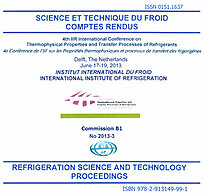
Document IIF
Etude sur la stabilité et les propriétés de nanofluides à base d'eau.
Investigation on stability and properties of water-based gold nanofluids.
Numéro : pap. n. TP-042
Auteurs : COLLA L., BLOSI M., SCATTOLINI M., et al.
Résumé
This paper investigates the stability, thermal and transport properties, and convective heat transfer coefficients of water-based nanofluids containing gold (Au) nanoparticles. Nanofluids were prepared with a one-step “eco-friendly” method, which exploits sodium citrate both as the reducing and chelating agents. A Dynamic Light Scattering (DLS) technique was used to measure the diameter of the suspended nanoparticles. Thermal conductivity and dynamic viscosity data for nanofluids with mass concentrations of 0.02 %, 0.05 % and 0.1 % were measured at atmospheric pressure in the temperature range between 10°C and 70°C. In order to evaluate the ability of nanofluids to improve the liquid phase heat transfer efficiency with respect to the base fluid, the convective heat transfer coefficient was experimentally measured in a dedicated experimental set-up. A constant heat flux was supplied to the fluid and the turbulent flow regime was investigated for various flow rates and inlet fluid temperatures, near ambient temperature. The measured thermal conductivity and dynamic viscosity data are used to determine the Reynolds and Nusselt numbers, and the nanofluid heat transfer coefficient coefficients are compared with pure water ones.
Documents disponibles
Format PDF
Pages : 298-305
Disponible
Prix public
20 €
Prix membre*
Gratuit
* meilleur tarif applicable selon le type d'adhésion (voir le détail des avantages des adhésions individuelles et collectives)
Détails
- Titre original : Investigation on stability and properties of water-based gold nanofluids.
- Identifiant de la fiche : 30008115
- Langues : Anglais
- Source : 4th IIR Conference on Thermophysical Properties and Transfer Processes of Refrigerants
- Date d'édition : 17/06/2013
Liens
Voir d'autres communications du même compte rendu (69)
Voir le compte rendu de la conférence
Indexation
- Thèmes : Mesures thermodynamiques
- Mots-clés : Propriété thermique; Coefficient de transfert de chaleur; Or; Stabilité; Nanofluide; Experimentation; Eau
-
Evaluation of the convective heat transfer perf...
- Auteurs : CALVINO U., VALLEJO J. P., BUSCHMANN M. H., FERNANDEZ-SEARA J., LUGO L.
- Date : 11/11/2020
- Langues : Anglais
- Source : X Congreso Ibérico y VIII Congreso Iberoamericano de Ciencias y Técnicas del Frío, CYTEF 2020.
- Formats : PDF
Voir la fiche
-
STUDY OF THE BEHAVIOUR OF HEAT AND MASS TRANSFE...
- Auteurs : RAMIREZ J., AYORA N., VIZCARRA M.
- Date : 1981
- Langues : Anglais
Voir la fiche
-
LABORATORY DETERMINATION OF THE THERMAL RESISTA...
- Auteurs : ELMAHDY A. H., BOWEN R. P.
- Date : 1988
- Langues : Anglais
Voir la fiche
-
EXPERIMENTAL DETERMINATION OF HEAT AND MASS TRA...
- Auteurs : DOWDY J. A., KARABASH N. S.
- Date : 1987
- Langues : Anglais
Voir la fiche
-
CALIBRATION OF A LOW TEMPERATURE HEAT FLOWMETER...
- Auteurs : SHEN J.
- Date : 24/08/1987
- Langues : Anglais
- Source : Development in refrigeration, refrigeration for development. Proceedings of the XVIIth international Congress of Refrigeration.
- Formats : PDF
Voir la fiche
